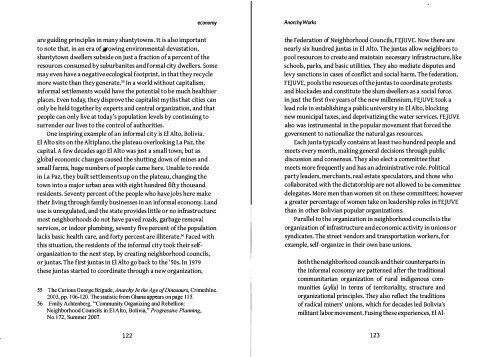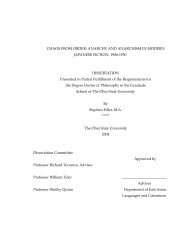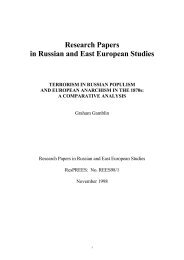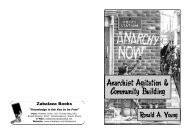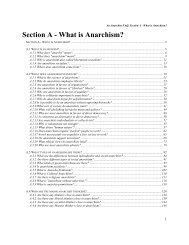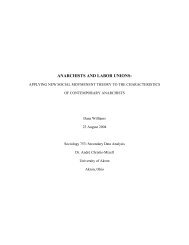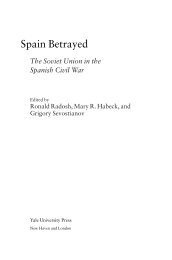Anarchy Works.pdf - Infoshop.org
Anarchy Works.pdf - Infoshop.org
Anarchy Works.pdf - Infoshop.org
You also want an ePaper? Increase the reach of your titles
YUMPU automatically turns print PDFs into web optimized ePapers that Google loves.
economy<br />
<strong>Anarchy</strong> <strong>Works</strong><br />
are guiding principles in many shantytowns. It is also important<br />
to note that, in an era of growing environmental devastation,<br />
shantytown dwellers subside on just a fraction of a percent of the<br />
resources consumed by suburbanites and formal city dwellers. Some<br />
may even have a negative ecological footprint, in that they recycle<br />
more waste than they generate.55 In a world without capitalism,<br />
informal settlements would have the potential to be much healthier<br />
places. Even today, they disprove the capitalist myths that cities can<br />
only be held together by experts and central <strong>org</strong>anization, and that<br />
people can only live at today's population levels by continuing to<br />
surrender our lives to the control of authorities.<br />
One inspiring example of an informal city is EI Alto, Bolivia.<br />
EI Alto sits on the Altiplano, the plateau overlooking La Paz, the<br />
capital. A few decades ago El Alto was just a small town, but as<br />
global economic changes caused the shutting down of mines and<br />
small farms, huge numbers of people came here. Unable to reside<br />
in La Paz, they built settlements up on the plateau, changing the<br />
town into a major urban area with eight hundred fifty thousand<br />
residents. Seventy percent of the people who have jobs here make<br />
their living through family businesses in an informal economy. Land<br />
use is unregulated, and the state provides little or no infrastructure:<br />
most neighborhoods do not have paved roads, garbage removal<br />
services, or indoor plumbing, seventy five percent of the population<br />
lacks basic health care, and forty percent are illiterate. 56 Faced with<br />
this situation, the residents of the informal city took their self<strong>org</strong>anization<br />
to the next step, by creating neighborhood councils,<br />
or juntas. The first juntas in EI Alto go back to the '50s. In 1979<br />
these juntas started to coordinate through a new <strong>org</strong>anization,<br />
55 The Curious Ge<strong>org</strong>e Brigade, <strong>Anarchy</strong> In the Age of Dinosaurs, Crimethlnc.<br />
2003, pp. 106-120. The statistic from Ghana appcars on page 115.<br />
56 Emily Achtenberg, "Community Organizing and Rebellion:<br />
Neighborhood Councils in ElAlto, Bolivia," Progressive Planning,<br />
No. 172, Summer 2007.<br />
the Federation of Neighborhood CouncUs, FEJUVE. Now there are<br />
nearly six hundred juntas in EI Alto. The juntas allow neighbors to<br />
pool resources to create and maintain necessary infrastructure, like<br />
schools, parks, and basic utilities. They also mediate disputes and<br />
levy sanctions in cases of conflict and social harm. The federation,<br />
FE]UVE, pools the resources of the juntas to coordinate protests<br />
and blockades and constitute the slum dwellers as a social force.<br />
In just the first five years of the new millennium, FE]UVE took a<br />
lead role in establishing a public university in EI Alto, blocking<br />
new municipal taxes, and deprivatizing the water services. FE]UVE<br />
also was instrumental in the popular movement that forced the<br />
government to nationalize the natural gas resources.<br />
Each junta typically contains at least two hundred people and<br />
meets every month, making general decisions through public<br />
discussion and consensus. They also elect a committee that<br />
meets more frequently and has an administrative role. Political<br />
party leaders, merchants, real estate speculators, and those who<br />
collaborated with the dictatorship are not allowed to be committee<br />
delegates. More men than women sit on these committees; however<br />
a greater percentage of women take on leadership roles in FEJWE<br />
than in other Bolivian popular <strong>org</strong>anizations.<br />
Parallel to the <strong>org</strong>anization in neighborhood councils is the<br />
<strong>org</strong>anization of infrastructure and economic activity in unions or<br />
syndicates. The street vendors and transportation workers, for<br />
example, self-<strong>org</strong>anize in their own base unions.<br />
Both the neighborhood councils and their counterparts in<br />
the informal economy are patterned after the traditional<br />
communitarian <strong>org</strong>anization of rural indigenous communities<br />
(ayllu) in terms of territoriality, structure and<br />
<strong>org</strong>anizational principles. They also reflect the traditions<br />
of radical miners' unions, which for decades led Bolivia's<br />
militant labor movement. Fusing these experiences, EI Al-<br />
122<br />
123


